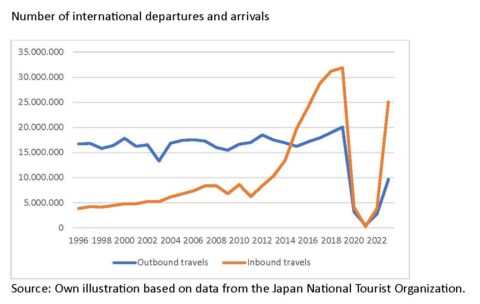Catchword ōbā-tsūrizumu
2024年9月30日, by Franz Waldenberger
More is not always better. Following the lifting of coronavirus-related entry restrictions in autumn 2022 and fuelled by the cheap yen, inbound tourism to Japan rapidly increased over the last two years. Although the figures for 2023 were still well below the 2019 level (see chart), a new record is emerging for 2024. By July, 60% more visitors than in the same period last year had flocked into the country. As before the pandemic, by far the most tourists were from Asia. However, while more than a third came from mainland China in 2019, it was only 12% in 2023. The gap was filled by visitors from South Korea. China has since caught up. In July 2024, it retook its first place among the regions of origin.
The tourist-boom generated revenues of 5.4 trillion yen in 2023, contributing 0.9% to gross domestic expenditure.[1] This is a very positive development in view of Japan’s demographically induced weak growth. However, there are also problems. The flow of visitors is not evenly distributed over space and time and, in many places, Japan’s infrastructure is not prepared for peaks in demand. A survey by the consulting firm EY revealed that 70% of the population are not opposed to tourism but 50% feel that there is ‘overtourism’ (ōbā-tsūrizumu), particularly in Kyoto, Tokyo and Nara. The manners of some of the visitors seem to be more of a problem than the overload of infrastructure. The EY report also proposes several countermeasures that are already in use at popular tourist places around the world: Additional charges or higher entrance fees, restrictions on bed capacity and the introduction of reservation systems to regulate tourist numbers.
In comparison, Japan still seems to have room for more visitors. The 25 million tourists in 2023 are significantly fewer in proportion to the country’s 124 million inhabitants when compared to the 35 million tourists in Germany, which are spread over a population of 84 million, or the 100 million tourists that 68 million French people had to cope with in 2023. Japan’s island location and the largely mountainous and inaccessible land areas certainly constrain its capacity for accommodating visitors. Nevertheless, tourism will continue to play an important role, especially for regions outside the urban centres. Japan’s attractiveness as tourist destination will also have a positive impact on the country’s soft power, especially in Asia.
[1] Own calculations based on the balance of payments statistics of the Bank of Japan and the national accounts of the Cabinet Office.
